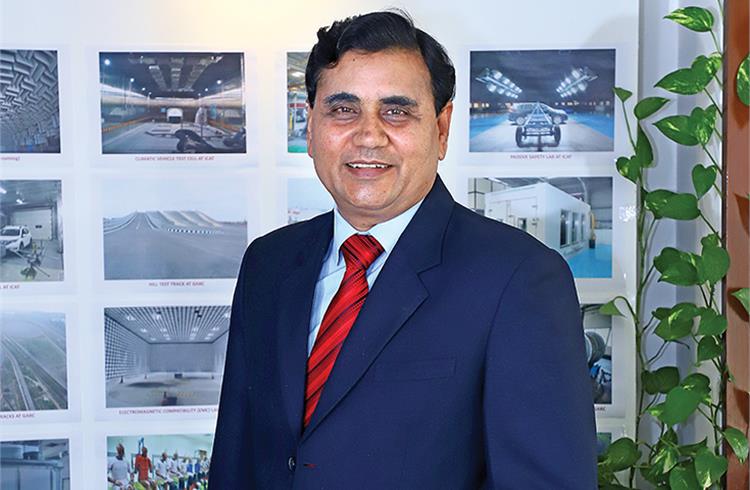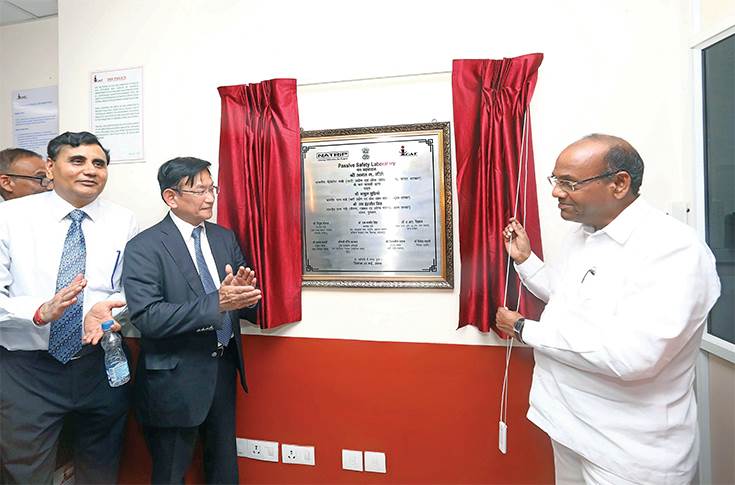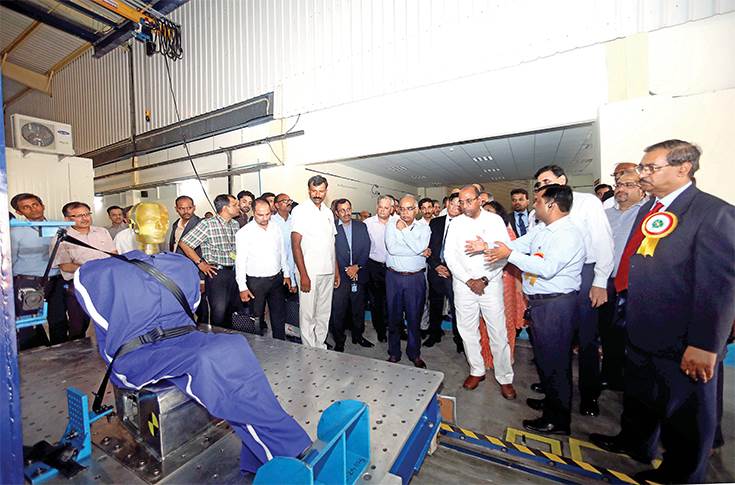Dinesh Tyagi: ‘We have the capability and the infrastructure to certify electric vehicles and hybrids’
The director of a testing facility in India that is capable to certify EVs.
In conversation with Autocar Professional, director, International Centre for Automotive Technology, Manesar reveals how critical the EMC testing would be for the EVs, the parameters for testing an EV and what role does ARAI play
Four new labs have been opened within iCAT. What purpose would the EMC lab serve? Is it going to be something specific to EVs?
No, it is to do with all kinds of vehicles, and EVs as well. It is about two aspects — the electromagnetic emissions from a vehicle, and its susceptibility from external radiation. When a vehicle moves in any environment, there are a lot of other vehicles surrounding it, and each is emitting its own electromagnetic radiation. So, none of the systems on the vehicle should malfunction because of outside interference. That is the immunity of the vehicle, just like the human body. On the other hand, there are regulatory guidelines controlling the permissible amount of radiation that can be emitted by a vehicle plying on the road. We need to test and certify that as well.
In that regard, would EMC testing be very critical for EVs, where the primary power source is going to be the Li-ion battery which would emit a lot of radiation?
The battery itself doesn't emit electromagnetic radiation, it is always the current. So, when current flows and electrons move in any circuit, there's an electromagnetic field which is created by the charged particles. They are the ones radiating emissions.
So, in EVs, since there would be a large flow of high current, EMC testing would become more important in these vehicles.
Is there any specific requirement from a test facility perspective, oriented more towards electric mobility?
We already have set up many facilities related to EVs and today we are in a position to certify EVs. We have actually certified two electric buses and also electric cars and hybrid vehicles. We now have the capability and the infrastructure to certify EVs and hybrids.
Also, at the component-level, we can test and validate ECUs, controllers as well as batteries. However, for the development of EVs, we are augmenting our facilities further. We are developing an EV test bed, and we are also buying new battery emulators. While we are already self-sufficient in terms of EV certification, all of these would be aimed at aiding EV development with OEs and component manufacturers.
What would be tested on the EV test bed?
On the EV test bed, we can test e-motors, characterise them, check their endurance as well as check their performance under varying environmental conditions like humidity, high temperature, under-voltage and over-voltage among many others.
iCAT's Dinesh Tyagi along with Kenichi Ayukawa, chairman and CEO, Maruti Suzuki India and Anant Geete, Union Minister of Heavy Industries & Public Enterprises, Government of India, at the inauguration of the NATRiP Passive Safety Laboratory in Manesar, on May 29
If there is a hybrid powertrain, we can check the engine and the motor together as they work in conjunction. So, we can calibrate as to when should the electric motor work, and what amount of load sharing there needs to be between the engine and the motor. All of this is calibration and is developmental work which could be carried out on these test beds.
When will this equipment be installed and what would be the investment needed?
We would install battery test beds and battery emulators in the current fiscal (FY2019). It would be done over an investment of Rs 10 crore.
What are the parameters on which EVs are certified today?
There are regulations laid out for EVs, which include specific component-level tests, as well as vehicle-level tests like the range test, energy efficiency test and 30-minute power test as well.
Would it be safe to say that the four new labs would really augment not only iCAT’s test capabilities, but the overall test infrastructure in India?
Of course, that's true. The EMC lab is only the second lab of its kind in the country. The first one was set up by NATRiP at VRDE Ahmednagar, which is operational for a few years now. With EMC regime becoming quite stringent, there is a lot of vehicle-level EMC test requirement today. While there are a number of component-level EMC chambers available at other places also, this is the only second full vehicle-level chamber in the country. So, we will complement and share VRDE’s load, which has been huge up until now.
In terms of crash lab, again, this is only the second lab after the one in ARAI, Pune, while the third lab at GARC, Chennai will still take some more time to be in place. With crash regulations already having been made mandatory for new models from October 2017, and slated to be extended to all existing models from October 2019, we will be catering to that upcoming demand.
Do ARAI and iCAT share the load?
There is no load-sharing formula as such. But, probably, ARAI is doing more work than us today as they had the lead with the centre getting established much earlier. Also, due to the clientele mix that they have, ARAI has more of local vehicle manufacturers like Tata Motors and Mahindra & Mahindra, which are based out of the western part of the country. On the other hand, our clientele includes a lot of MNCs, which have their own testing facilities, and thus there is a slight imbalance in that sense.
In the West, Centres of Excellence (CoEs) are very prominent. Is the government also looking to make iCAT a CoE as well?
Yes, iCAT is identified as a CoE for component development and for NVH, but only under NATRiP. However, through our own initiatives, we have set up a CoE in powertrain development and tyre testing. These are our own initiatives, and we are doing well in these areas. So, there are two CoEs from NATRiP and two from our own end. Eventually, we will grow all our labs into CoEs.
What is the timeline you are looking at to reach that level?
Maybe, it will take another five years for all the laboratories to come up to that level that we could then be recognised as a reliable product development partner.
There are multiple labs at iCAT now. Are there still areas which you would want to add to the portfolio of labs?
Well, nothing specific comes to my mind as such. We have already installed labs beyond NATRiP, for instance, the automotive electrical and electronics lab, tyre and wheel testing lab, both of these have been our own initiatives. The powertrain CoE is more of a consulting business, where we participate with OEMs, helping them with their powertrain development.
Things have not moved according to the plan under NATRiP. What are your thoughts?
Yes, things have been much delayed. However, we have been fortunate that in iCAT, the projects were handed over for execution and our teams have done a splendid job. I am very happy with that.
So, which are the areas where you still need to cover some distance under NATRiP?
At iCAT, almost everything is over, except for the test track, which would be over by October. The entire iCAT project under NATRiP would then be completed this year itself. The other big centre is the GARC in Chennai, and I hope that too would be completed within this year.
What is the plan to add the test tracks at iCAT?
Our test tracks are very basic and won't have huge capabilities, and will be meant only for doing homologation. One will not be able to do much of developmental work here. For that, the proving grounds at Natrax, in Indore are the go-to place. They have a variety of test tracks and a huge investment has gone into it.
The Passive Safety Lab also offers sled test capability
But, sustaining it financially is going to be a very big challenge. There has been a huge investment of Rs 1,800 crore into the project itself and if the land cost is also taken into consideration, then it escalates to somewhere between Rs 2,500 to Rs 3,000 crore. It is huge money. I hope it can be done but they will not earn so much of money.
For operations, they can sustain, but if one does a proper RoI calculation, the money would not be recovered. Though it's government money at the end of the day, but somewhere one has to keep an account.
At iCAT, we follow proper accounting. We operate in 17 business units and have a P&L account for each of them. Overall, we are profitable, in fact, surplus.
In terms of new regulations, what is the update on BNCAP? When is it expected to get implemented?
Bharat New Car Assessment Programme (BNCAP) is dormant at the moment. Nobody is taking a lead on it. Maybe, once the crash regulations encompass all vehicle segments by 2019, and the market has experienced it for a couple of years, so, it could come into the picture by around 2021.
Coming back to electric mobility, are e-rickshaws regulated as well?
Yes, e-rickshaws are perfectly regulated and were brought under the Type Approval regime around five years ago. However, CoP is still not there, and it is under discussion and being considered to be implemented, maybe within a year.
Are you also going to contribute to OEMs in development of EVs as well as charging infrastructure?
EVs, yes, but charging infrastructure, I don't think so.
The government is also promoting alternate propulsion technologies, like the MNRE approving a pilot project for hydrogen. What are your views?
Hydrogen is being talked about for quite some time now, but it has not succeeded because the availability is a big question. Once it is made available in abundance and its transportation and storage issues can be handled, then we could see some progress being made.
With ARAI, VRDE, iCAT, and the GARC coming up, where would you rate India's testing infrastructure today on the global map?
I think we have one of the best testing infrastructures in the world today. The NATRiP was a very unique initiative by the government and is well appreciated the world over. It did get delayed but, barring that, testing infrastructure is great. Of course, a few things will remain country-specific, but we have most of the required testing facilities inside iCAT. Ours is really the best facility, which is better than ARAI and others.
So, can an OEM today make India its global production hub and export products all over the world?
That was absolutely the intent of setting up these centres under NATRiP. For instance, the NVH lab, fatigue lab, CAD/CAE lab, and the AEEI lab have nothing to do with certification. Many of our labs are aimed at supporting product development and make Indian OEMs self-sufficient and globally competitive.
Finally, what is the split of your business coming in from vehicle OEMs and component manufacturers?
At this moment, probably, more from OEMs. While the majority of these are Indian manufacturers, our global business is not so huge. Big OEMs do have their own facilities and it is also about the capability. We have plans to engage more with OEM majors for product development. We are already doing small things, we aim to scale it higher. The majority of our clients are OEs, around 70 percent of the total customer pool.
(This interview was first published in the June 15 2018 issue of Autocar Professional)
RELATED ARTICLES
BRANDED CONTENT: 'We aspire to be among the leading sensors and electro-mechanical products manufacturer'
P. Parthasarathy, Founder & Managing Director, Rotary Electronics Pvt Ltd shares the company's commitment and vision to ...
‘Big opportunity for startups lies in products in India’: Detlev Reicheneder
As electrification levels the playing field, the focus on tech and R&D to bring innovative products is the mantra for st...
'I hope my journey makes people say — I can do this too'
Ranjita Ravi, Co-founder of Orxa Energies — the maker of Mantis e-bikes — shares the challenges of building a startup an...





 07 Sep 2018
07 Sep 2018
 16246 Views
16246 Views







 Autocar Pro News Desk
Autocar Pro News Desk




